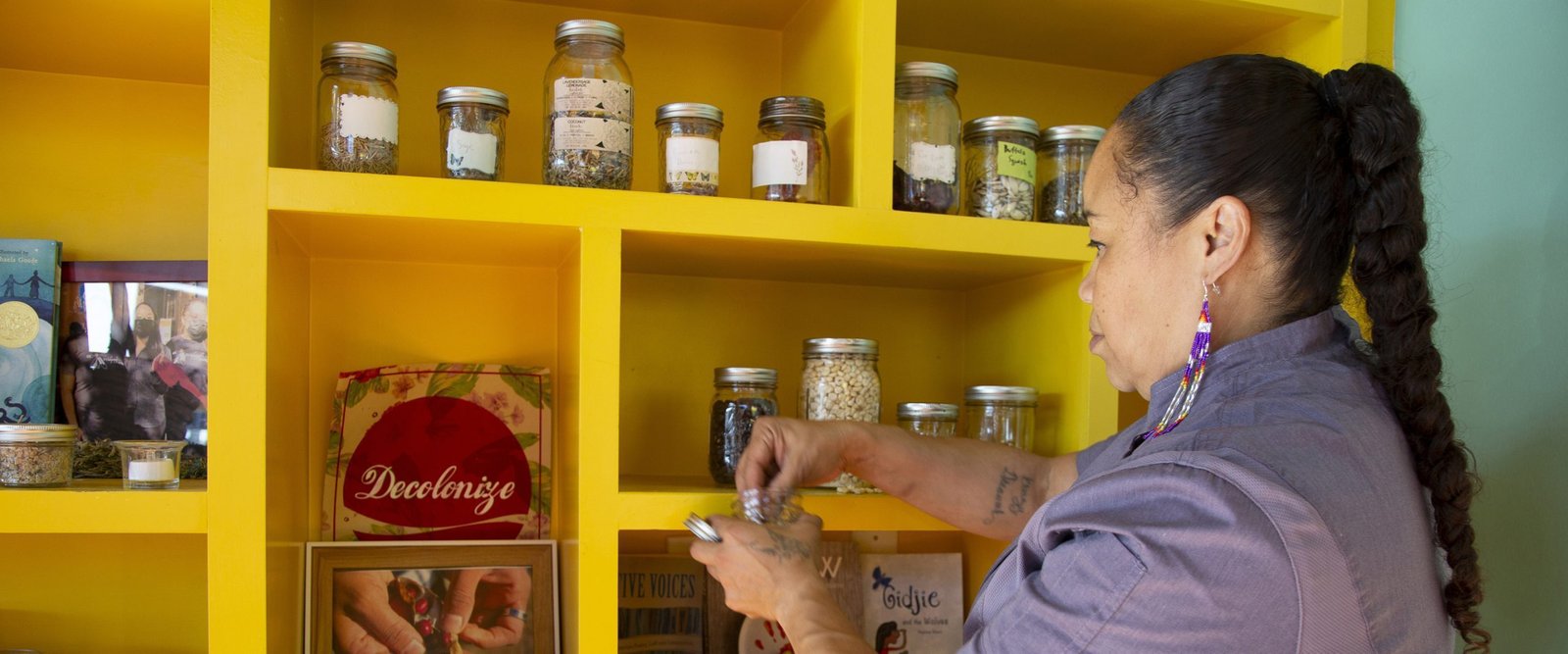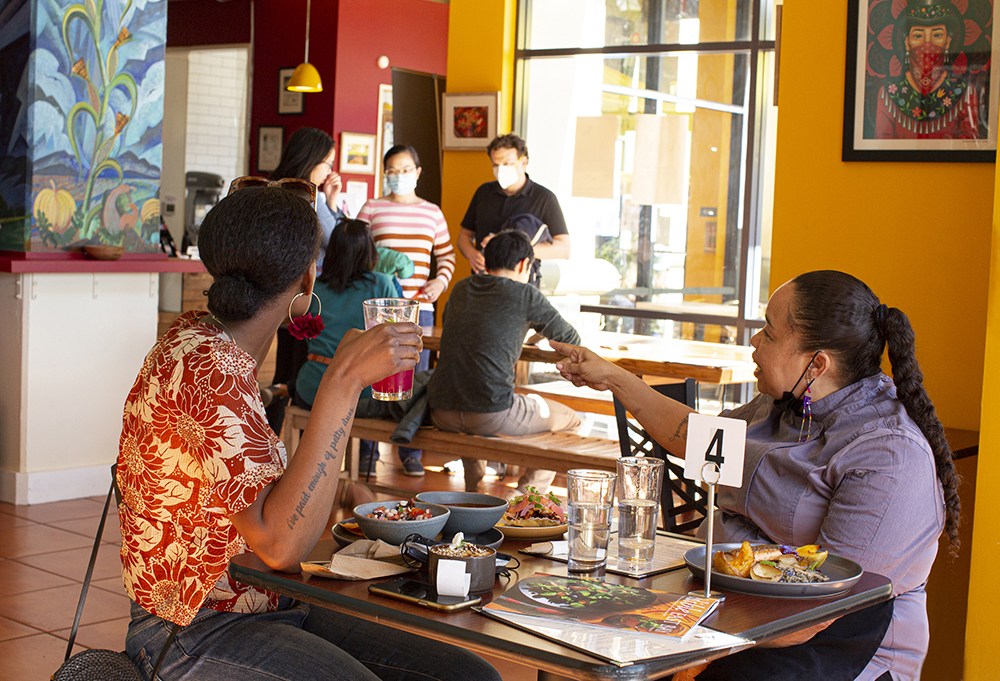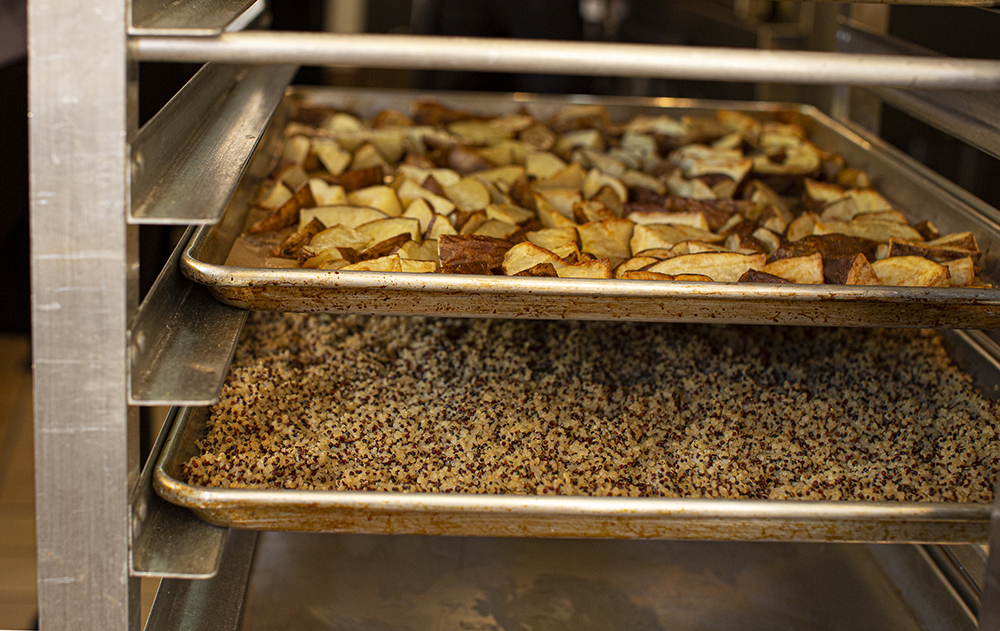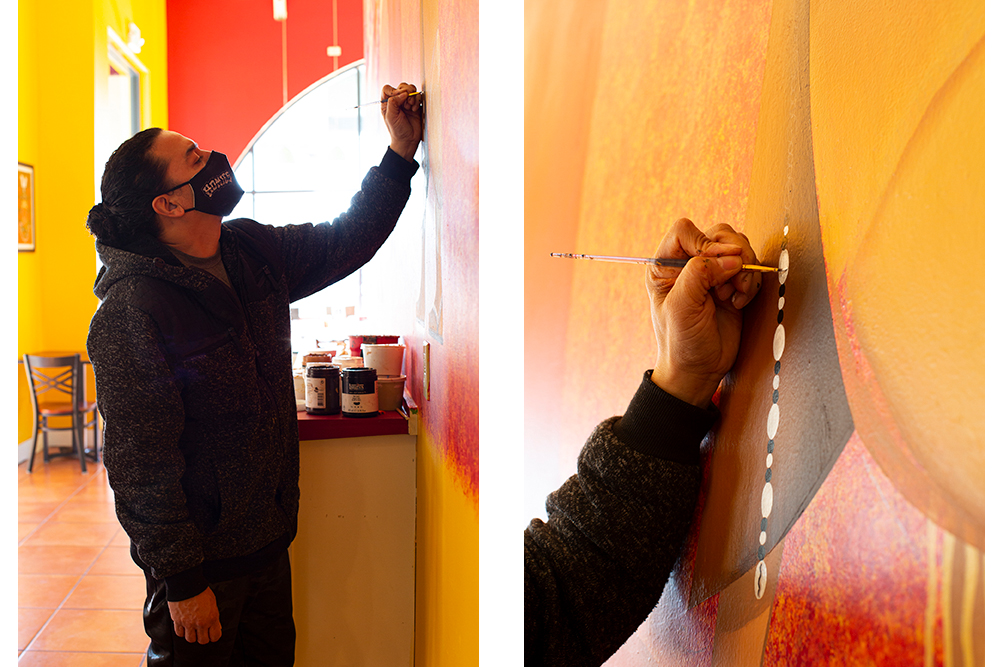Latest Job Opportunities in India
Discover top job listings and career opportunities across India. Stay updated with the latest openings in IT, government, and more.
Check Out Jobs!Read More
✨ Discover The land on which we live: the cultivation of links through the components of the indigenous population in WahpePah’s
— the latest insights
Today’s article:
In the dining room in WahpePah kitchenYour eyes are immediately painted into a bright yellow wall of shelves that display a variety of glass jars, each full of seeds in various shapes, sizes and colors. As they are beautiful, these seeds are not just a decoration – they have an important role they play in directing those who eat dinner in the restaurant to look at the ground under their table and the food it places on it.
“I want people to see what they eat and where it comes and how we save our seeds,” says Chef Crystal and Wahiba in describing the decision to give the seeds a prominent place in the restaurant, which is located on OHLONE land in Auckland. California.
For wapepah, the first generation in her family who was born in Auckland, a member of the Kickapoo nation in Oklahoma, the desire to make people closer to food in this way is rooted in a history that much exceeds the cultivated direction to the table that has become common in the Gulf region in recent years.
WahpePah recalls: “He grew up in a culturally diverse city with access to many different types of food,” “We will always have our own foods inside my grandparents and the homes of my mother and inside our society, but I was always wondering why we eat food in restaurants.
This date extends over the past five centuries, as European colonists violently violently American tribes of their ancestors, thus destroying and exposing thousands of years of original food traditions. Any original seeds, as well as cooking and agricultural knowledge, which remain today have been protected and carefully moved over generations.
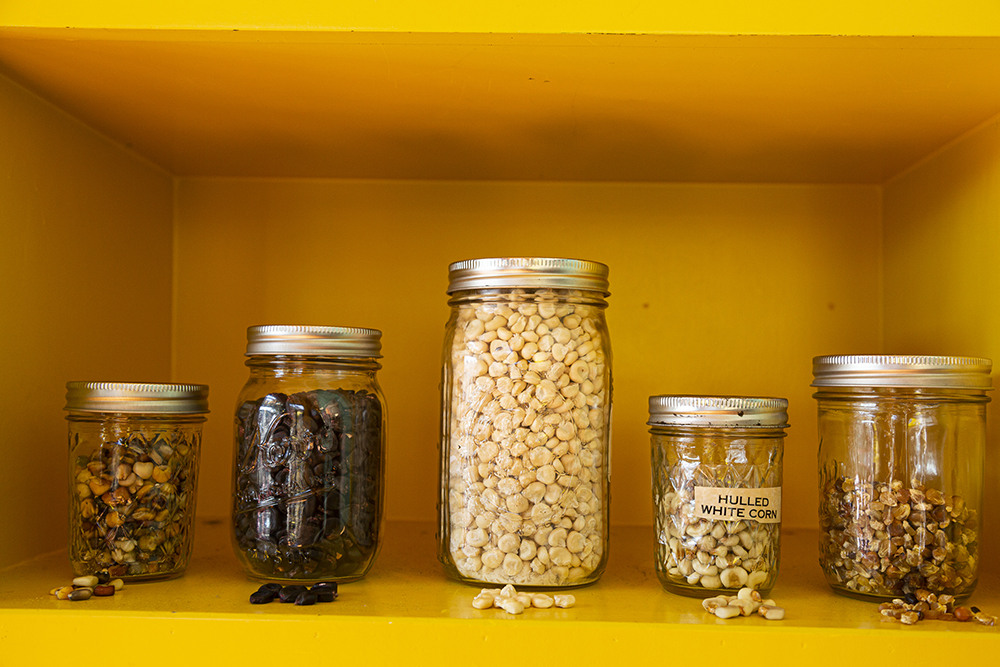
(From left to right) The corn of the lint, the perurofic blue atom, the Mohawk atom, the summit with the roasted atom.
“She has always been attracted towards the original American food and took it upon him at a very early age to want to know more,” says WahpePah, who started cooking when she was seven. “I finished getting recipes that were transferred to me by my grandparents and my mother, and I will ask my family to make the traditional corn soup with which I grew up.”
A beautiful and difficult trip
WahpePah, who was not originally aspiring to be a chef, describes the sequence of events that led to the opening of the restaurant in November 2021 as a “beautiful, beautiful journey”. For twenty -five years, she moved from the cooking meal for her approach to feeding hundreds of people in one day.
“Something has led to someone, and I was the person who would call him to manufacture original foods,” WahpePah explains about family and friends and in the end companies all over the country who asked WahpePah to meet the events specifically because of their reputation as a chef with a deep understanding of the original kitchen.
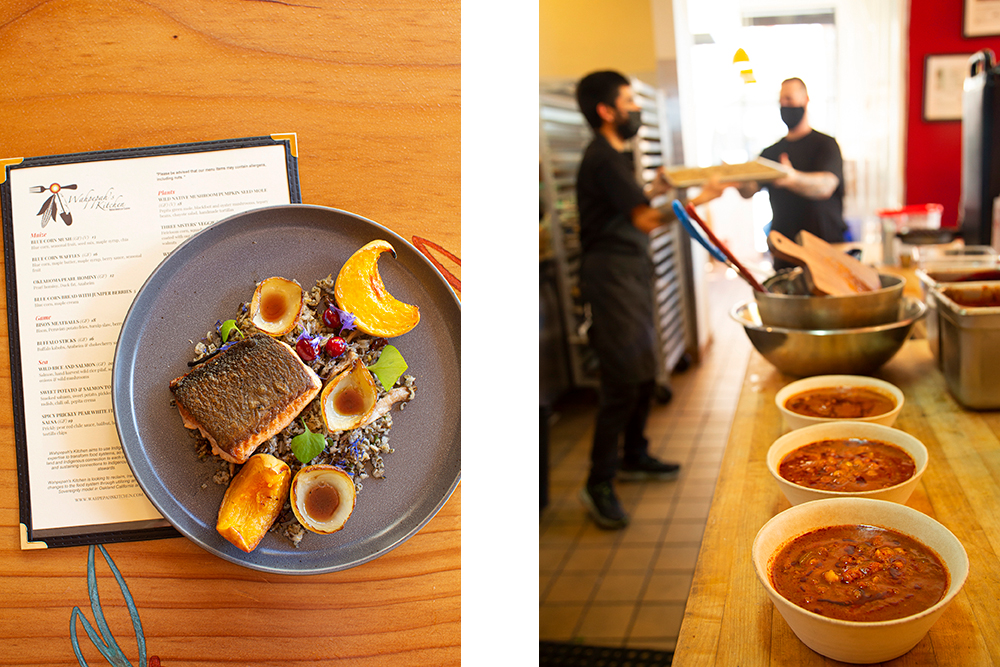
(Left) A plate of wild rice and salmon with squash, onions, onions and wild mushrooms highlights the menu behind it. (Right) In the kitchen, the generous vessels of Kickapoo Bison Chili are waiting to be immersed with inherited blue corn bread.
For more than a decade, the WahpePah kitchen has flourished as a food serving company, but in 2020, the joint commercial kitchen was forced as WahpePah was cooking on the closure as a result of the Covid-19 epidemic. “All I have has stopped, but I wanted to continue this task I was,” says WahpePah. “I felt in my heart that it was time for me to have space.”
This space has become a version of bricks and mortars from the WahpePah kitchen, which serves, in the words of WahpePah, a “indigenous and vital community” consisting of “more than 100,000 indigenous Americans from different tribes” in the surrounding urban neighborhoods. And she confirms that the restaurant is the result of “a lot of hard work and many years. This was not a disregard.”
The years of effort and experience in wapepah not only cooking original foods, but also engaging in conversations with indigenous and indigenous people about these foods that led them to determine the three goals that direct the WahpePah kitchen: “(1) to admit that we live on stolen lands; 2) on the health benefits of original food methods.”
Thanks to WahpePah’s accurate sources of the components of the original societies, each dish in the list provides an opportunity for those who eat in the restaurant to learn more about the original foods and support the original farmers. When doing this, wapepah directly contributes to the continued traditions of agriculture and the original cooking, as well as helping the movement towards food sovereignty among the indigenous population.
“Our blue atom comes from the uf nation (in the southwest of the United States). ACORN is newly ground from the mono nation, which is located in Fresno. They did not come overnight. “
WahpePah’s dedication is not limited to forming relations within the country’s original community on the food suppliers in the restaurant. Soon after the opening, wapepah began cooperation with a collective art and original activity known as NSRGNTS to draw a mural on a wall in WahpePah’s kitchen around the historical historical corridors between South America and Central America and North America. Speaking of this project, wapehpah notes, “I had many people from the original community who wanted to give somehow and tell me that I am on the right path.”
We have to make it known to our future generations that we are here and will not go anywhere
It is very important for WahpePah the relationship she sponsored with Ramona Farms in Arizona, which provides red corn inheritance in Kickapoo Chili (based on her grandmother’s recipe) that she is preparing for her in the restaurant.
“It is one of the oldest tribes with which the inheritance atom adheres to,” WahpePah explains about society on Ramona farms and it is noted that this atom and many other components that it confiscates in the restaurant are only available in limited quantities for short periods of time. “If there are six bags of corn available, I will get these six bags and we will use them. For this reason when you come to WahpePah kitchen, you will not see the same over and over again – you will see what is in the season.” The constantly changing list is not the result of chasing the seasonal chefs in order to be modern, but rather an indication of the scarcity of some of the original components resulting from generations of systemic persecution, including barriers that prevent access to land.
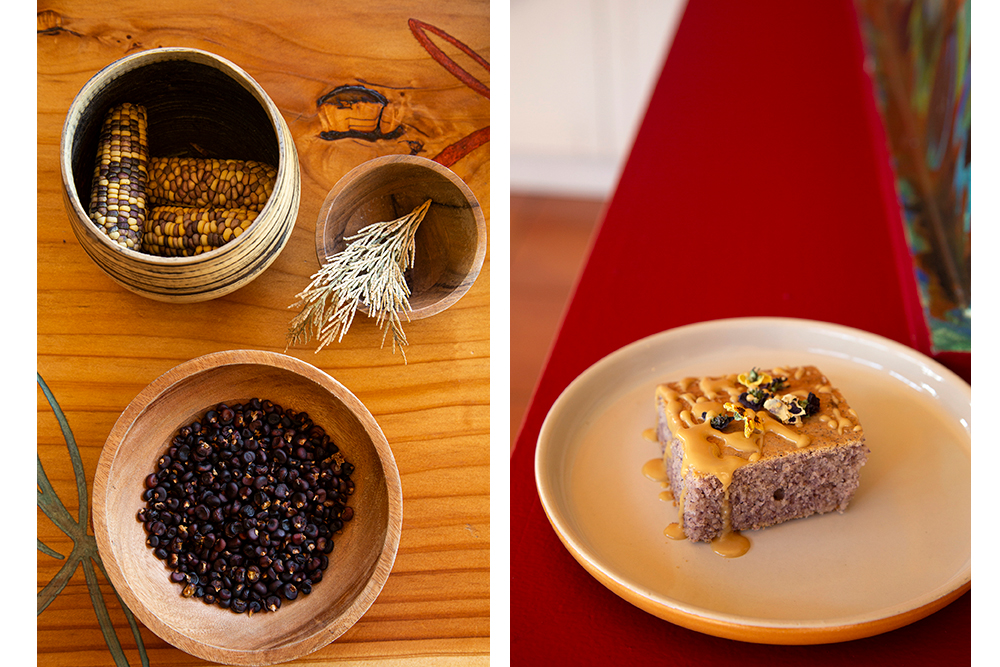
(Left) Raw ingredients used in the Wahpeh Kitchen menu includes blue blue corn (lower vessel), oakhauma homani corn (over the left) and juniper paper (on the right). (Right) A plate of blue corn bread with juniper berries, wearing maple cream and edible flowers.
For some people, WahpePah kitchen provides an opportunity to face certain components for the first time, and for others, the restaurant is a space for reunification. “I am talking to some people and saying:” I hadn’t had a blue atom since I was 18 years old! “They are thirty.” I have people who come from all over that they were not on their reservations or their citizens for a long time. “
Our food is that relationship that we must deal with our society
The existence of a space to collect and share a meal that has grown and prepared by indigenous Americans is unique and invaluable in building a healthier and healthy future for the indigenous population.
“Our food is that relationship that we must deal with for our community to recover,” says WahpePah. “I have grandmother’s grandmother to cry and say in their lives they have never thought that they will see a original American restaurant … Sometimes he really tries to have a restaurant, but when I hear that, I know I did my job.”
Only a few months have passed since WahpePah’s kitchen received his first guests, but wapepah is already looking forward to the future. She hopes that her hard work will inspire the opening of other restaurants owned by Americans. “I grew up, I liked to see an original American restaurant. This is what we want our youth to see today and we hope to see more,” says WahpePah. “We have to make it known to our future generations that we are here and will not go anywhere – and we need them to bear this.”
The seeds on the shelves in the WahpePah kitchen, like the restaurant itself, are physical representation and a reminder of all the previous generations of indigenous Americans to continue at the present time, and the way in which something can grow very small into a very big thing (even in an unstable environment) and how one person affects the lives of many. However, what we see above the ground in the seed germinate or open a restaurant is only part of the story; In the story of WahpePah, the roots are less important.
WahpePah’s most deep contribution to reclamation of the original dining methods is the supportive root system that has planted it over the years of forming relationships with indigenous farmers not only to maintain its own business, but to help the entire original community with prosperity. By using the original ingredients in the WahpePah kitchen, the WahpePah Chef connects and puts it, restores our attention to the land on which we live and provide a model for other restaurants to join them in working on food justice for all.
Elena Valeriote is a food writer who specializes in food that shows our collective strength to create a more equitable and sustainable diet. With experience in many different links in the supply chain ranging from production to distribution, as well as hospitality, food policy, and beyond, Elena’s comprehensive approach to writing food draws attention to the value of the Earth, plants, animals and people who feed us every day. You can learn more about her work in https://www.lenavalerote.com/portfolio.
Norma Cordova is an American Mexican artist, who was born in Oregon by the Mexican immigrant fathers working hard. Its topic ranges from daily moments of food, travel and people, to femininity, self -identity and wonder. Her work was shown in the United States and abroad, and was recently published in New Yorker, New York Times, Deputy, PDN and Lenscratch. You can find her work in Normacordova.comand Shesaidred.comAnd delivery @shesaidred.
Read the full article at: https://www.goodfoodjobs.com/blog/the-land-we-live-on/
Don’t miss out with Good Food Jobs
—
**Additional Resources & Tags:**
– Written by: admin
– Published on: 2022-03-15 16:31:00
– Tags: , Uncategorized,agriculture,culinary,education
– Related Rules: [rule_{ruleNumber}], [rule_{ruleNumber}_plain]
**Visuals & Media:**
– Featured Image: https://www.goodfoodjobs.com/blog/wp-content/uploads/2022/03/feature-photo-1-scaled-e1647278717566.jpg
– Enclosure Link:
**URL & Links:**
– Post URL (slug): the-land-on-which-we-live-the-cultivation-of-links-through-the-components-of-the-indigenous-population-in-wahpepahs
– Encoded URL: https%3A%2F%2Fwww.goodfoodjobs.com%2Fblog%2Fthe-land-we-live-on%2F
– Decoded URL: https://www.goodfoodjobs.com/blog/the-land-we-live-on/
– Redirect URL: https://www.goodfoodjobs.com/blog/the-land-we-live-on/
– Source Domain: www.goodfoodjobs.com
**Meta & Miscellaneous:**
– Publication Time: 1758517601
– Hashtags: #land #live #cultivation #links #components #indigenous #population #WahpePahs
– Custom Prompt/Note: Prompt
—
**Sample Post Title:** The land on which we live: the cultivation of links through the components of the indigenous population in WahpePah’s


